Then… two things
1. One can only train a learner on a finite number of images… so some specific other images may well benefit from a deviation from presets
2. Does anybody know if the nxt defaults changed from before to after bxt release… betcha Russ would know!
jim
|
You cannot like this item. Reason: "ANONYMOUS".
You cannot remove your like from this item.
Editing a post is only allowed within 24 hours after creating it.
You cannot Like this post because the topic is closed.
Copy the URL below to share a direct link to this post.
This post cannot be edited using the classic forums editor.
To edit this post, please enable the "New forums experience" in your settings.
Dan Kearl:
My other point, IMO, was that there was no reason for you to become aggressive.
I apologize, I took some of your phrasing the wrong way,,
That being said, I just think that people who develop software set defaults and parameters for a reason.
Of course there are sliders that go from 0-100 but there must be a good reason Croman chooses 90 and 15. I assume its not random and it suits
the algorithms he uses best.
Much like any software, Adobe Camera Raw in Photoshop chooses a WB, you can adjust it if you want but clearly they are using algorithms they feel gives the best WB.
Same with Capture One and other photo software.
Blurex has defaults, I doubt Croman made those up either and you can adjust if you want but it's not random numbers he chooses.
I tend to go with the expert and since he developed it, unless I know better I will use his. Regarding your point on the setting of 15 for sharpening, I disagree. That there are settings at all for noise reduction strength or sharpening means that the processes likely have differing effects on different data sets, and no, Russ cannot know every possible use of these tools. The fact that there is a sharpening component to this noise reduction tool, to me, is an acknowlegement from Russ that the denoise process of his tool causes some "de-sharpening" effect, however slight and his suggestions as a default at 10 or 15 is to counteract that. But anyone who uses these sorts of tools should only take any default setting only as a suggested starting point. If, for you, it works as you want, then nothing more to be said. However, if all you do is just use it, without making the effort to try these functions at different settings, then you may be missing something good or bad. If his settings were simply the best, no matter what the situation, there would be no options to change the settings. Fact is, if you set the sharpening to 0, and I have at times, the noise reduction is very good, if impossible to tell the difference with sharpening set to 15. In any case, no need to assume Russ knows best, when it is so simple to know for sure for your data.
|
You cannot like this item. Reason: "ANONYMOUS".
You cannot remove your like from this item.
Editing a post is only allowed within 24 hours after creating it.
You cannot Like this post because the topic is closed.
Copy the URL below to share a direct link to this post.
This post cannot be edited using the classic forums editor.
To edit this post, please enable the "New forums experience" in your settings.
Alan Brunelle:
Regarding your point on the setting of 15 for sharpening, I disagree. That there are settings at all for noise reduction strength or sharpening means that the processes likely have differing effects on different data sets, and no, Russ cannot know every possible use of these tools. I just used 0 instead of 15 on some images and I cannot tell the difference at 400%. I can tell if I lower the noise slider from 90 of course and If you have REALLY clean data it does make sense to do that. Again, I went to a Pixinsight class taught by Kevin Moorfield last week who has like 38 IOTD here, and he uses 15 on his data from Chile. Your mileage may vary.
|
You cannot like this item. Reason: "ANONYMOUS".
You cannot remove your like from this item.
Editing a post is only allowed within 24 hours after creating it.
You cannot Like this post because the topic is closed.
Copy the URL below to share a direct link to this post.
This post cannot be edited using the classic forums editor.
To edit this post, please enable the "New forums experience" in your settings.
I'm not sure exactly who I might be disagreeing with, but the idea of default settings being on just about every slider and setting entry on every function in PI is not new. That Russ has a default is therefore not surprising. So I have no trust in any default settings, "just because". I do suspect that many defaults are probably pretty benign. Doesn't mean they are the best settings.
For NXT, the tool is for noise reduction. If the sharpening function has no function than to sharpen (here Russ could have explained why there is even a sharpen function on NXT), then it has no use for me. I have often left it at default though with no problem. However, noise reduction seems to work fine alone.
Some history here. NXT came out long before BXT and I used it early. At that point I discovered the the sharpening function worked better that the PI Deconvolution (and way easier!), so I used it as my deconvolution tool briefly. But when I used it that way, the denoise slider was set to zero!
In any case, using sub-region of an image makes fast work of knowing what works, what doesn't, and what the best settings are.
What Kevin uses on a benign, subtle setting such as this may mean that he just doesn't care or want to take the 5 seconds to change it. Did anyone actually ask him the what, why, when, how, and where of the sharpening function? PI has too many functions that have too many settings and are understood by, like three people…
|
You cannot like this item. Reason: "ANONYMOUS".
You cannot remove your like from this item.
Editing a post is only allowed within 24 hours after creating it.
You cannot Like this post because the topic is closed.
Copy the URL below to share a direct link to this post.
This post cannot be edited using the classic forums editor.
To edit this post, please enable the "New forums experience" in your settings.
Okay I tried NXT on duplicates of the same image (monochrome), comparing versions with different levels of Detail: All of the NXT ones have 85 Denoise: (left image immediately below, to the left, named "NoNXT" has no denoise) (all images afterwards will be named (XX)Detail according to what the Detail was set to, in increments of 15) 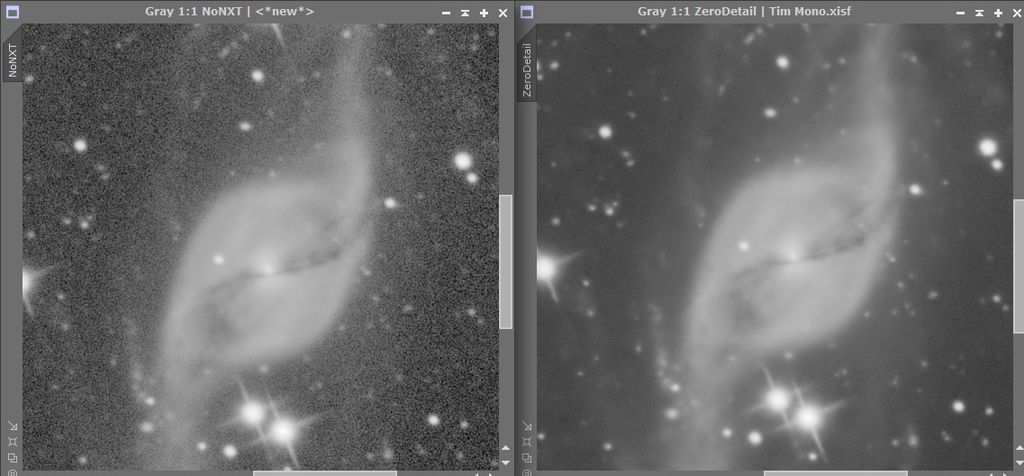 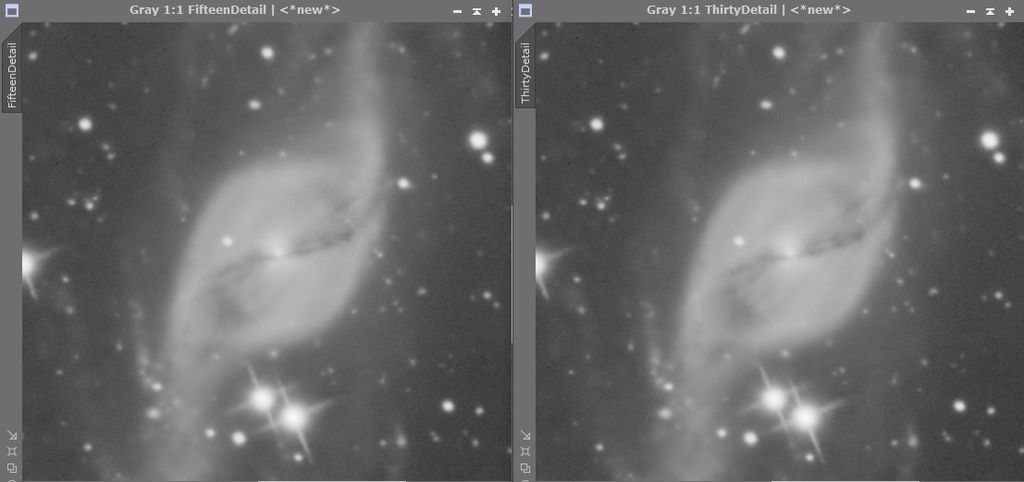 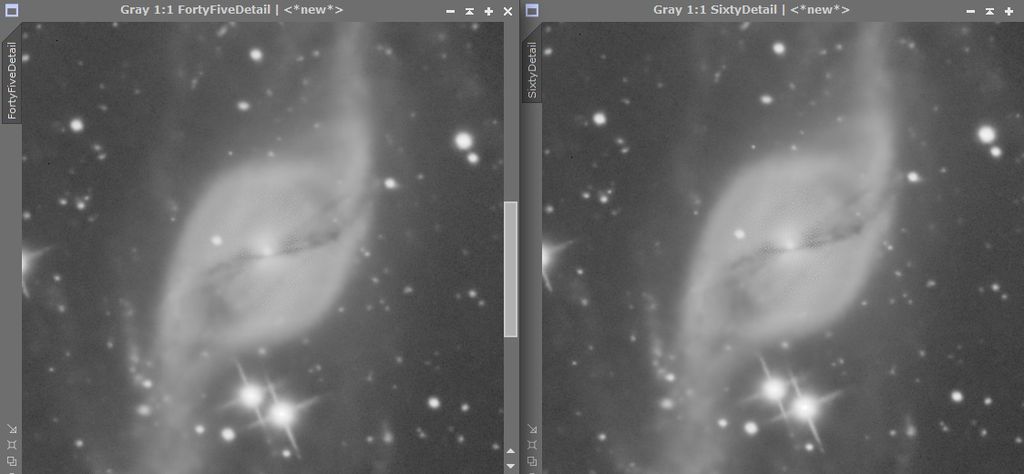 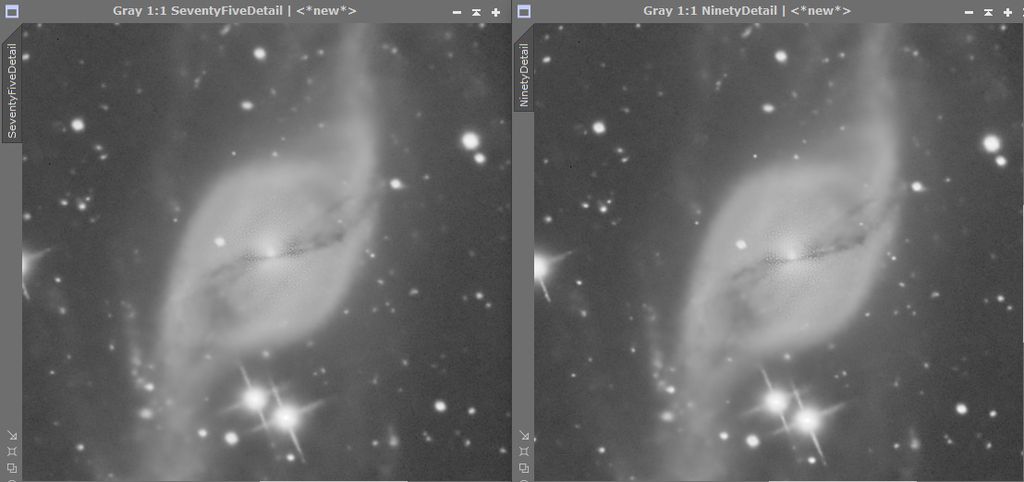 The difference that caught my eye the most was what was happening in the center of the galaxy, the coarse grittiness. (zoom in to see better) So I guess Detail 15 is fine, but now I really don't know what is the benefit of that if the difference is this miniscule at that Detail level. I would say the bad effects start happening at 45 Detail. Note that this is just one random galaxy, and I don't know how different my comparison would be when using a different subject, like a nebula.
|
You cannot like this item. Reason: "ANONYMOUS".
You cannot remove your like from this item.
Editing a post is only allowed within 24 hours after creating it.
You cannot Like this post because the topic is closed.
Copy the URL below to share a direct link to this post.
This post cannot be edited using the classic forums editor.
To edit this post, please enable the "New forums experience" in your settings.
So I guess Detail 15 is fine, but now I really don't know what is the benefit of that if the difference is this miniscule at that Detail level.
I would say the bad effects start happening at 45 Detail. The benefit is you don't have to screw around changing settings for miniscule results. This is what software developers do so you don't have to. I think only in Astrophotography do people think they are smarter than the software. I don't know of any Landscape photographer who thinks they need to check and measure all Photoshop settings to see if they got it right.....
|
You cannot like this item. Reason: "ANONYMOUS".
You cannot remove your like from this item.
Editing a post is only allowed within 24 hours after creating it.
You cannot Like this post because the topic is closed.
Copy the URL below to share a direct link to this post.
This post cannot be edited using the classic forums editor.
To edit this post, please enable the "New forums experience" in your settings.
Dan Kearl:
So I guess Detail 15 is fine, but now I really don't know what is the benefit of that if the difference is this miniscule at that Detail level.
I would say the bad effects start happening at 45 Detail.
The benefit is you don't have to screw around changing settings for miniscule results.
This is what software developers do so you don't have to.
I think only in Astrophotography do people think they are smarter than the software.
I don't know of any Landscape photographer who thinks they need to check and measure all Photoshop settings to see if they got it right..... But it makes me think, why did Russ Croman have to set it to 15 as default if he knew there was basically no difference between that and 0? But yeah, from now on I'll be keeping Detail at default, thx.
|
You cannot like this item. Reason: "ANONYMOUS".
You cannot remove your like from this item.
Editing a post is only allowed within 24 hours after creating it.
You cannot Like this post because the topic is closed.
Copy the URL below to share a direct link to this post.
This post cannot be edited using the classic forums editor.
To edit this post, please enable the "New forums experience" in your settings.
First of all, thanks for the work creating the comparison. Very interesting and to my eye the zero detail image is just a touch sharper than the 15. It begs the question what sort of data would benefit from the more aggressive levels?
|
You cannot like this item. Reason: "ANONYMOUS".
You cannot remove your like from this item.
Editing a post is only allowed within 24 hours after creating it.
You cannot Like this post because the topic is closed.
Copy the URL below to share a direct link to this post.
This post cannot be edited using the classic forums editor.
To edit this post, please enable the "New forums experience" in your settings.
Don't you think sharpening should be left to BXT and noise reduction to NXT?? NXT predates BXT by quite a while and I suspect Russ included sharpening there as an early attempt to sharpen / deconvolve. Once BXT arrived, I suspect the sharpening in NXT is essentially deprecated. I'd bet whatever sharpening you might achieve w/ NXT you'd do just as well or better w/ BXT even if it needs to be a second time later in your workflow. Haven't test this extensively, but it kinda makes sense…
|
You cannot like this item. Reason: "ANONYMOUS".
You cannot remove your like from this item.
Editing a post is only allowed within 24 hours after creating it.
You cannot Like this post because the topic is closed.
Copy the URL below to share a direct link to this post.
This post cannot be edited using the classic forums editor.
To edit this post, please enable the "New forums experience" in your settings.
First of all, thanks for the work creating the comparison. Very interesting and to my eye the zero detail image is just a touch sharper than the 15. It begs the question what sort of data would benefit from the more aggressive levels? thx. don't know, good question. James Sokolowski:
Don't you think sharpening should be left to BXT and noise reduction to NXT?? NXT predates BXT by quite a while and I suspect Russ included sharpening there as an early attempt to sharpen / deconvolve. Once BXT arrived, I suspect the sharpening in NXT is essentially deprecated. I'd bet whatever sharpening you might achieve w/ NXT you'd do just as well or better w/ BXT even if it needs to be a second time later in your workflow. Haven't test this extensively, but it kinda makes sense... I do agree with you I'm gonna ask Russ right now what he thinks about his NXT Detail tool. LOL, I'm gonna say to him, "WHAT WERE YOU THINKING!?"   No, just kidding, I'll obviously be more respectful than that.
|
You cannot like this item. Reason: "ANONYMOUS".
You cannot remove your like from this item.
Editing a post is only allowed within 24 hours after creating it.
You cannot Like this post because the topic is closed.
Copy the URL below to share a direct link to this post.
This post cannot be edited using the classic forums editor.
To edit this post, please enable the "New forums experience" in your settings.
okaaaaay, I just bombarded him with questions!   nah, just four questions.
|
You cannot like this item. Reason: "ANONYMOUS".
You cannot remove your like from this item.
Editing a post is only allowed within 24 hours after creating it.
You cannot Like this post because the topic is closed.
Copy the URL below to share a direct link to this post.
This post cannot be edited using the classic forums editor.
To edit this post, please enable the "New forums experience" in your settings.
I don’t believe the detail slider is intended to be a sharpening tool per se, but as has been mentioned, just a compensation adjustment for the blurring caused by de-noising.
Cheers,
Scott
|
You cannot like this item. Reason: "ANONYMOUS".
You cannot remove your like from this item.
Editing a post is only allowed within 24 hours after creating it.
You cannot Like this post because the topic is closed.
Copy the URL below to share a direct link to this post.
This post cannot be edited using the classic forums editor.
To edit this post, please enable the "New forums experience" in your settings.
Hi, coming back to the very first question (how you setup the tools) I use NXT after a classical sequence SPCC, DBE (or the reverse according to the result), BXT (correct only then classic). NXT is sometimes used in linear sometimes after stretching. When I have strong stretch to do I see that NXT before stretch avoids to introduce strong noise around faint nebulosity after stretch. The default settings of NXT (below) tells that detail enhancement should be tuned to what you see in preview with a recommandation for best setting. On my own I use preview, zoom down to small details and I observed that NXT reduces the level of detail produced by BXT on some fine details. So I push "detail" to just compensate this effect and get both noise reduction while maintaining the details as seen in the preview before applying NXT. Usually I get something around 0.25 to 0.35. This is my humble experience, I recognize that some people prefer still a little bit noisy images and reduces the denoise button to 0.6. Personnaly as long as I check carrefully that my settings are not producting artifacts I play only with "detail". Frédéric 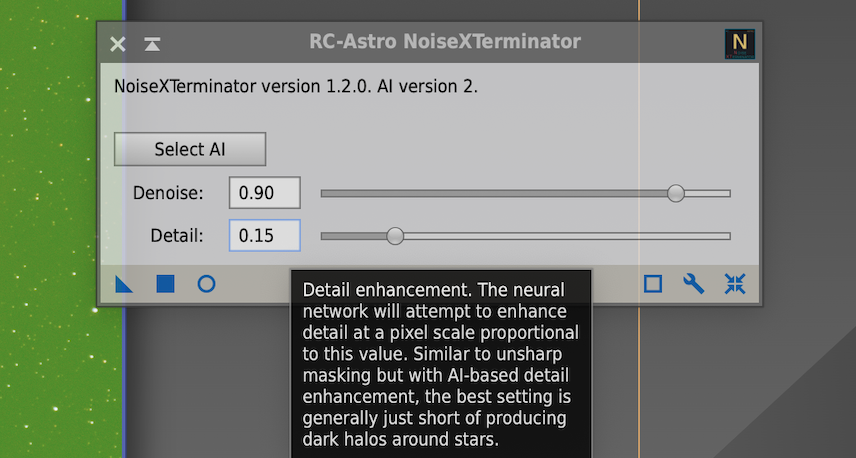 |
You cannot like this item. Reason: "ANONYMOUS".
You cannot remove your like from this item.
Editing a post is only allowed within 24 hours after creating it.
You cannot Like this post because the topic is closed.
Copy the URL below to share a direct link to this post.
This post cannot be edited using the classic forums editor.
To edit this post, please enable the "New forums experience" in your settings.
Correct me if I am wrong, but I believe Russell and Adam Block both recommend using BXT prior to NXT. BXT helps to recover the PSF and NXT may destroy that process if used first.
|
You cannot like this item. Reason: "ANONYMOUS".
You cannot remove your like from this item.
Editing a post is only allowed within 24 hours after creating it.
You cannot Like this post because the topic is closed.
Copy the URL below to share a direct link to this post.
This post cannot be edited using the classic forums editor.
To edit this post, please enable the "New forums experience" in your settings.
I'm pretty sure the idea of running BXT prior to NXT is that BXT was trained on images prior to their being noise reduced… and astronomical image noise is unique compared w/ typical terrestrial imagery… so it makes sense to do BXT then NXT later
|
You cannot like this item. Reason: "ANONYMOUS".
You cannot remove your like from this item.
Editing a post is only allowed within 24 hours after creating it.
You cannot Like this post because the topic is closed.
Copy the URL below to share a direct link to this post.
This post cannot be edited using the classic forums editor.
To edit this post, please enable the "New forums experience" in your settings.
Hi in this video Russell Croman explains why blurxterminator works much better before any noise reduction. Russell Croman explains bxt |
You cannot like this item. Reason: "ANONYMOUS".
You cannot remove your like from this item.
Editing a post is only allowed within 24 hours after creating it.
You cannot Like this post because the topic is closed.
Copy the URL below to share a direct link to this post.
This post cannot be edited using the classic forums editor.
To edit this post, please enable the "New forums experience" in your settings.
Frédéric Ruciak:
Hi in this video Russell Croman explains why blurxterminator works much better before any noise reduction.
Russell Croman explains bxt any chance you can provide the Cliff's Notes version of the 2 hour video?? Jim
|
You cannot like this item. Reason: "ANONYMOUS".
You cannot remove your like from this item.
Editing a post is only allowed within 24 hours after creating it.
You cannot Like this post because the topic is closed.
Copy the URL below to share a direct link to this post.
This post cannot be edited using the classic forums editor.
To edit this post, please enable the "New forums experience" in your settings.
Hi Jim, at 1h02mn of the video, R.C. starts to explain the limitation of deconvolution and speak about noise. I do not have the note you mention.
Frederic
|
You cannot like this item. Reason: "ANONYMOUS".
You cannot remove your like from this item.
Editing a post is only allowed within 24 hours after creating it.
You cannot Like this post because the topic is closed.
Copy the URL below to share a direct link to this post.
This post cannot be edited using the classic forums editor.
To edit this post, please enable the "New forums experience" in your settings.







